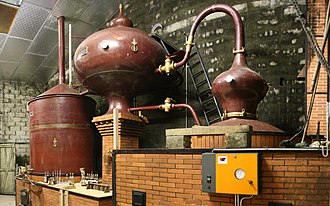Cognac





Type of brandy
Template:Infobox alcoholic beverage
Cognac is a type of brandy named after the town of Cognac in France. It is produced in the surrounding wine-growing region in the departments of Charente and Charente-Maritime. Cognac production falls under French appellation d'origine contrôlée (AOC) designation, with production methods and naming required to meet certain legal requirements.
Production[edit]
Cognac is made from white wine that is very dry, acidic, and thin. Though it is made from grapes, it is distilled twice in copper pot stills and aged at least two years in French oak barrels from Limousin or Tronçais. The production process is strictly regulated by the Bureau National Interprofessionnel du Cognac (BNIC).
Grapes[edit]
The primary grape used in the production of cognac is Ugni blanc, known locally as Saint-Emilion. Other permitted grape varieties include Folle blanche and Colombard.
Distillation[edit]
The wine is distilled twice in traditional copper pot stills known as "alambic charentais." The first distillation, known as "brouillis," results in a liquid with an alcohol content of about 30%. The second distillation, called "la bonne chauffe," refines the spirit to about 70% alcohol.
Aging[edit]
After distillation, the cognac is aged in oak barrels. The aging process imparts flavor and color to the spirit. The length of aging determines the quality and classification of the cognac. The minimum aging period is two years, but many cognacs are aged much longer.
Classifications[edit]
Cognac is classified based on the length of time it has been aged:
- VS (Very Special): Aged at least two years.
- VSOP (Very Superior Old Pale): Aged at least four years.
- XO (Extra Old): Aged at least ten years.
Regions[edit]
The Cognac region is divided into six zones, known as "crus," each with its own distinct characteristics:
Notable Brands[edit]
Some of the most well-known cognac brands include:
See also[edit]
References[edit]
<references group="" responsive="1"></references>
External links[edit]
Ad. Transform your life with W8MD's Budget GLP-1 injections from $75


W8MD offers a medical weight loss program to lose weight in Philadelphia. Our physician-supervised medical weight loss provides:
- Weight loss injections in NYC (generic and brand names):
- Zepbound / Mounjaro, Wegovy / Ozempic, Saxenda
- Most insurances accepted or discounted self-pay rates. We will obtain insurance prior authorizations if needed.
- Generic GLP1 weight loss injections from $75 for the starting dose.
- Also offer prescription weight loss medications including Phentermine, Qsymia, Diethylpropion, Contrave etc.
NYC weight loss doctor appointmentsNYC weight loss doctor appointments
Start your NYC weight loss journey today at our NYC medical weight loss and Philadelphia medical weight loss clinics.
- Call 718-946-5500 to lose weight in NYC or for medical weight loss in Philadelphia 215-676-2334.
- Tags:NYC medical weight loss, Philadelphia lose weight Zepbound NYC, Budget GLP1 weight loss injections, Wegovy Philadelphia, Wegovy NYC, Philadelphia medical weight loss, Brookly weight loss and Wegovy NYC
|
WikiMD's Wellness Encyclopedia |
| Let Food Be Thy Medicine Medicine Thy Food - Hippocrates |
Medical Disclaimer: WikiMD is not a substitute for professional medical advice. The information on WikiMD is provided as an information resource only, may be incorrect, outdated or misleading, and is not to be used or relied on for any diagnostic or treatment purposes. Please consult your health care provider before making any healthcare decisions or for guidance about a specific medical condition. WikiMD expressly disclaims responsibility, and shall have no liability, for any damages, loss, injury, or liability whatsoever suffered as a result of your reliance on the information contained in this site. By visiting this site you agree to the foregoing terms and conditions, which may from time to time be changed or supplemented by WikiMD. If you do not agree to the foregoing terms and conditions, you should not enter or use this site. See full disclaimer.
Credits:Most images are courtesy of Wikimedia commons, and templates, categories Wikipedia, licensed under CC BY SA or similar.
Translate this page: - East Asian
中文,
日本,
한국어,
South Asian
हिन्दी,
தமிழ்,
తెలుగు,
Urdu,
ಕನ್ನಡ,
Southeast Asian
Indonesian,
Vietnamese,
Thai,
မြန်မာဘာသာ,
বাংলা
European
español,
Deutsch,
français,
Greek,
português do Brasil,
polski,
română,
русский,
Nederlands,
norsk,
svenska,
suomi,
Italian
Middle Eastern & African
عربى,
Turkish,
Persian,
Hebrew,
Afrikaans,
isiZulu,
Kiswahili,
Other
Bulgarian,
Hungarian,
Czech,
Swedish,
മലയാളം,
मराठी,
ਪੰਜਾਬੀ,
ગુજરાતી,
Portuguese,
Ukrainian
